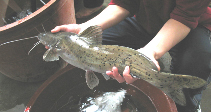Upload your photos and videos
Pictures | Google imageHemibagrus guttatus
Picture by Yang, L.
Pictures | Google imageHemibagrus guttatus
Picture by Yang, L.
Classification / Names Populärnamn | synonymer | Catalog of Fishes(Släkte, Arter) | ITIS | CoL | WoRMS | Cloffa
> Siluriformes (Catfishes) > Bagridae (Bagrid catfishes)
Etymology: Hemibagrus: Greek, hemi = the half + Mozarabic, bagre, Greek, pagros = a fish, Dentex sp. (Ref. 45335).
More on author: Lacepède.
Etymology: Hemibagrus: Greek, hemi = the half + Mozarabic, bagre, Greek, pagros = a fish, Dentex sp. (Ref. 45335).
More on author: Lacepède.
Environment: milieu / climate zone / depth range / distribution range Ekologi
; sötvatten bottenlevande. Subtropical
Utbredning Länder | FAO områden | Ekosystem | Förekomster | Point map | Utplanteringar | Faunafri
Asia: Nam Xam and Nam Ma basins in Laos and Red River basin in Viet Nam and Yunnan, southeastern China.
Size / Vikt / Age
Maturity: Lm ? range ? - ? cm
Max length : 73.1 cm SL hane/ej könsbestämd; (Ref. 115027); common length : 18.5 cm SL hane/ej könsbestämd; (Ref. 35840); publicerad maxvikt: 4.9 kg (Ref. 115027)
Max length : 73.1 cm SL hane/ej könsbestämd; (Ref. 115027); common length : 18.5 cm SL hane/ej könsbestämd; (Ref. 35840); publicerad maxvikt: 4.9 kg (Ref. 115027)
Short description Bestämningsnycklar | Morfologi | Morfometri
Taggstrålar i ryggfenan (totalt) : 2; Mjukstrålar i ryggfenan (totalt) : 7; Mjukstrålar i analfenan: 10 - 16; Ryggkotor: 53. Smooth head, covered by thin membrane. The maxillary barbel could reach pelvic fin. Well developed adipose fin, about 3 times the length of the dorsal fin, starting from near the back of the dorsal fin. Body nude without scale. Complete lateral line from the head till the caudal fin. Light brownish in color, white in stomach (Ref.33423). Body with a few scattered black spots (Ref. 43281).
Adults inhabit large rivers, with current (Ref. 43281). Oviparous, distinct pairing possibly like other members of the same family (Ref. 205).
Life cycle and mating behavior Könsmognad | Reproduktion | Lek | Ägg | Fecundity | Larver
Main reference
Upload your references | referenser | Koordinator | Medarbetare
Kottelat, M., 2001. Fishes of Laos. WHT Publications Ltd., Colombo 5, Sri Lanka. 198 p. (Ref. 43281)
IUCN Red List Status (Ref. 130435: Version 2024-2)
Data deficient (DD) ; Date assessed: 24 January 2011
CITES
Not Evaluated
Threat to humans
Harmless
Human uses
Fiskeri: kommersiell
FAO - Publication: search | FishSource |
Ytterligare information
Trophic ecology
Födoslag
Födosammansättning
Födointag
Food rations
Predatorer
Födoslag
Födosammansättning
Födointag
Food rations
Predatorer
Ecology
Ekologi
Ekologi
Population dynamics
Tillväxtparametrar
Max. ages / sizes
Length-weight rel.
Length-length rel.
Length-frequencies
Mass conversion
Rekrytering
Abundans
Tillväxtparametrar
Max. ages / sizes
Length-weight rel.
Length-length rel.
Length-frequencies
Mass conversion
Rekrytering
Abundans
Life cycle
Reproduktion
Könsmognad
Maturity/Gills rel.
Fecundity
Lek
Spawning aggregations
Ägg
Egg development
Larver
Larvdynamik
Reproduktion
Könsmognad
Maturity/Gills rel.
Fecundity
Lek
Spawning aggregations
Ägg
Egg development
Larver
Larvdynamik
Anatomy
Gälyta
Brain
Otolith
Gälyta
Brain
Otolith
Physiology
Body composition
Nutrients
Syreförbrukning
Swimming type
Simhastighet
Visual pigments
Fish sound
Diseases & Parasites
Toxicity (LC50s)
Body composition
Nutrients
Syreförbrukning
Swimming type
Simhastighet
Visual pigments
Fish sound
Diseases & Parasites
Toxicity (LC50s)
Human related
Aquaculture systems
Vattenbruksprofiler
Avelslinjer
Ciguatera cases
Stamps, coins, misc.
Aquaculture systems
Vattenbruksprofiler
Avelslinjer
Ciguatera cases
Stamps, coins, misc.
Verktyg
E-book | Fälthandbok | Bestämningsnycklar | Längdfördelnings-verktyg | Livshistorie-verktyg | Prickkarta | Classification Tree
| Catch-MSY |
Special reports
Download XML
Internet-källor
AFORO (otoliths) | Aquatic Commons | BHL | Cloffa | BOLDSystems | Websites from users | Check FishWatcher | CISTI | Catalog of Fishes: Släkte, Arter | DiscoverLife | ECOTOX | FAO - Publication: search | Faunafri | Fishipedia | Fishtrace | GenBank: genome, nucleotide | GloBI | Google Books | Google Scholar | Google | IGFA World Record | MitoFish | Otolith Atlas of Taiwan Fishes | PubMed | Reef Life Survey | Socotra Atlas | Tree of Life | Wikipedia: Go, sök | World Records Freshwater Fishing | Zoological Record
Estimates based on models
Phylogenetic diversity index (Ref. 82804): PD50 = 0.5000 [Uniqueness, from 0.5 = low to 2.0 = high].
Bayesian length-weight: a=0.01047 (0.00649 - 0.01690), b=2.92 (2.79 - 3.05), in cm total length, based on LWR estimates for this species & (Sub)family-body (Ref. 93245).
Trofisk nivå (Ref. 69278): 3.7 ±0.6 se; based on size and trophs of closest relatives
Resiliens (Ref. 120179): Mycket låg, lägsta populationsfördubblingstid mer än 14 år (Preliminary K or Fecundity.).
Fishing Vulnerability (Ref. 59153): High vulnerability (56 of 100).




